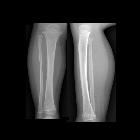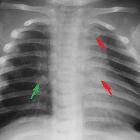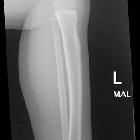toddler fracture











A toddler fracture is a minimally or undisplaced spiral fracture, usually of the tibia, typically encountered in toddlers. It is a potentially difficult diagnosis to establish on account of both the symptoms and imaging findings being subtle.
Terminology
The term has sometimes also been used to describe occult fractures of other lower limb bones in the same age group (e.g. fibula, cuboid, calcaneum ). It is important to note that this does not include spiral femoral fractures, which should raise suspicion of non-accidental injury .
Epidemiology
Toddler fractures typically occur between nine months and three years of age and are believed to be the result of new stresses placed on the bone due to recent and increasing ambulation.
Although early reports suggested that tibial toddler fractures were indicative of non-accidental injury, subsequent work has suggested that this is not the case and that the vast majority are not suspicious . As such they should not raise the alarm when present in isolation and the correct age group (i.e. ambulating toddlers).
Clinical presentation
Children typically with vague symptoms, not clearly related to the tibia. Usually, they refuse to weight-bear and are irritable.
Radiographic features
Plain radiograph
Conventional radiographs are all that are required, however, multiple views may be necessary as the fracture is often inapparent on one or more views. Internal oblique projection can better demonstrate the fracture in some cases . Nondisplaced oblique fracture will be noted in the middle or distal diaphysis of the tibia .
If despite multiple views, no fracture can be identified, follow-up radiographs usually will demonstrate slight sclerosis and periosteal reaction.
Treatment and prognosis
Toddler fractures usually require no treatment and spontaneously heal.
History and etymology
J S Dunbar first described toddler fractures in 1964 .
Differential diagnoses
Siehe auch:
und weiter:

 Assoziationen und Differentialdiagnosen zu Toddler-Fraktur Kleinkind-Fraktur:
Assoziationen und Differentialdiagnosen zu Toddler-Fraktur Kleinkind-Fraktur:


